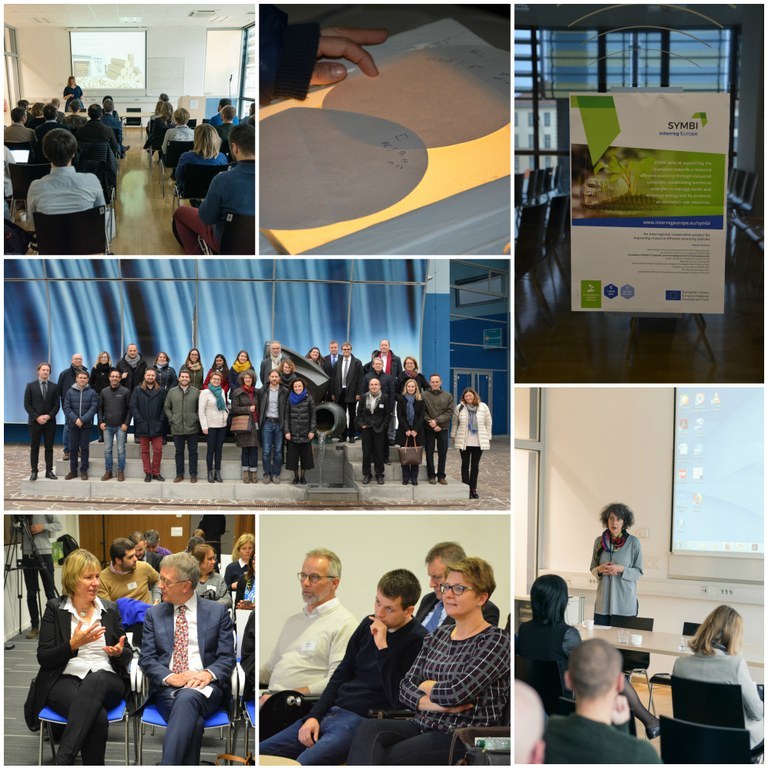Industrial symbiosis paves the way towards circular economy

Ljubljana, 21–22 November 2017 – Government Office for Development and European Cohesion Policy, partner in the Interreg project Symbi, hosted a two-day international conference Circular Economy and Industrial Symbiosis: Incentives, Key Enablers and Challenges’’. Slovenian Minister for Development, Strategic Projects and Cohesion Alenka Smerkolj gave the welcome address.
Government Office for Development and European Cohesion Policy, partner in the project Symbi (Industrial symbiosis for a resource efficient economy) which is implemented under the Interreg Europe Programme, is following up the development and deployment of the concepts of circular economy and industrial symbiosis, both at the national and EU-wide level. It is focused on topics that are particularly relevant for Slovenia and supports the achievement of the set strategic goals. To this end, the Government Office organised a conference and a study visit on 21 and 22 November in Ljubljana, Slovenia to bring together project partners and stakeholder groups from Spain, Poland, Hungary, Italy, Finland and Greece as well as other interested parties to discuss and share views on the challenge of closing the gap between the markets for primary and secondary raw materials and on the use of financial instruments to support industrial symbiosis projects, and to disseminate good practice.
Minister Smerkolj briefed on the activities of Slovenia related to mainstreaming circular economy and underlined how important its role was by saying that ‘’If we want to ensure that our and future generations have a decent life, we need to move away from traditional linear consumption and production patterns to a model that supports circular economy. Such a shift requires our full commitment and dedication, because it will not just happen on its own.’’ The Minister stressed that our economies need a structured, horizontal and integrated approach across all levels, and referred to the project Symbi as an excellent learning platform offering the stakeholders insight into how other EU countries are going about the issue. ‘’Everything we learn from this project is valuable and invites us to revisit and rethink our own actions, which helps us shape quality strategic documents,’’ she concluded.
On the sidelines of the conference, the Minister met with Peter Laybourn, the founder of International Synergies Limited (UK) and the creator of the National Industrial Symbiosis Programme. The programme, which has already been exported to over 20 countries across five continents, seeks to improve regional and national efforts to mainstream industrial symbiosis and, in turn, pave the way towards sustainable regional development. The implementation of the programme reveals that once companies embrace industrial symbiosis, they can significantly improve their competitiveness, and at the same time successfully reduce environmental pressures.
On the first day of the conference the participants from both public and private sector discussed and exchanged views on waste separation, processing and transformation, and addressed the issue of how to close the gap between primary and secondary raw materials. The representative of the Ministry of the Environment and Spatial Planning presented the national waste management legislation and outlined some of the challenges that hinder the transition to a circular economy. The representative of the Centre for European Political Studies delivered a presentation on the simplifications and transparency of economic models. The representative of the Wuppertal Institute for Climate, Environment and Energy reminded of the importance of embracing the concept of waste prevention. The representatives of SITRA – The Finnish Innovation Fund shared cases of good practice in this area. SITRA is one of the leading foundations involved in design and implementation of policies that support the shift to a circular economy. Good practices also included the project RusaLCA, which deals with wastewater treatment and reuse of treated wastewater in other sectors and was presented by the representative of Slovenian National Building and Civil Engineering Institute, and the project Celkrog (English: FullCircle) which seeks to tap the overlooked potentials of biomass and was presented by the director of the Pulp and Paper Institute.
On the second day of the conference the participants discussed the potential use of financial instruments to support the industrial symbiosis projects. The debate featured the representatives of the Ministry of Economic Development and Technology, Eco Fund - Slovenian Environmental Public Fund and the company Kolektor Venture.
The project partners also got the opportunity to participate in study visits to learn about Slovenian good practices, including to the company VIPAP VIDEM Krško d.d. which is the largest producer of paper in Slovenia using recycled fiber obtained from recovered paper in deinking process as the main raw material, and Aquapark Atlantis. The latter is an excellent example of industrial symbiosis between two companies – BTC d.d. company and AquafilSLO. The excess thermal energy generated during the regeneration process where waste such as fishing nets and textile scraps becomes secondary raw material used for production of nylon yarn in the company AquafilSLO is transferred to the nearby water park to heat the water in the swimming pools or to heat the premises of the Millenium Sports Centre, which significantly reduces CO2 emissions.
More about Symbi
